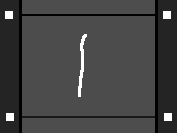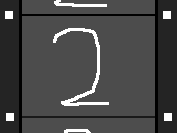
Brakhage's

Arabics


[This essay was originally commissioned by the L. A. Filmforum, which used it as program notes for their 1997 showings of the complete Arabics. It was also reprinted in the booklet for Anthology Film Archives's Film Preservation Honor for 2001, which can be purchased from Anthology.]
While Stan Brakhage's diverse output includes a wide variety of films in each period, there has always been a group that I've thought of as the "main line" of his work. Usually his strongest and most original films, they are also the ones that expand his limits, that push his work into new territory. Even before the somnambulist-protagonist puts out his eyes in the early The Way to Shadow Garden, Brakhage's long filmmaking career had begun to follow a particular trajectory, an arch that stretches further and further away from the given. The impulse has always been to obliterate social conventions of eyesight in favor of something more original, more unpredictable, more unruly.
One could draw a line from The Wonder Ring and Anticipation of the Night through The Art of Vision, certain of the shorter Songs (perhaps 7, 8, 13, 16, 21, 22), 23rd Psalm Branch, short films of the early 70s such as The Process, The Riddle of Lumen, and Aquarien straight through to Brakhage's first long venture into "full abstraction," The Text of Light. And what one would find in each of these works is an internal struggle, a process worked out in the imagery and the editing, between things that seem predictable — the movements of the train in The Wonder Ring, or the topography of San Francisco in Song 7 — and cinematic elements which interrupt or disrupt the ways in which we expect to see these things, such as the frames-within-frames created by the intrusion of Brakhage's fingers into the cityscapes of Song 7.
On a superficial level, this struggle can appear as a tension between representation and abstraction, and this can even said to describe The Text of Light, in which patterns of refracted light seen through a crystal ash-tray become metaphors for landscapes. But this neglects an additional, and deeper process at work, which has to do with the way Brakhage plays with composition and rhythm. The way he will often place objects or areas of light right at the frame's edge, even partly cut off by that edge, tends to create images that seem to be pulling themselves apart, almost as if on the brink of fissure. More, the films' rhythms always seem perched on a kind of knife-edge of unpredictability, in which a light pattern lasts only just long enough to be recognized as a pattern: at the moment when the viewer, recognizing it, thinks he can predict what will come next, a sudden shift transforms it into something else, almost as if the time-signature of a piece of music has changed, pulling the ground out from under one's feet.
All of this has a very major point in Brakhage's oeuvre: he seeks an original vision which is something quite different from what has been handed down to us through existing aesthetic traditions, or from what the conventions of functional seeing we have all learned, in order to navigate through our rooms and streets, give us in our daily lives. This quest for the new has, as it does in different ways in much modernist art, a further point: the viewer, confronted with something different and unexpected, is suddenly required to figure the work out for herself, and becomes more aware of her individual responses, all of which may be "correct." Brakhage's work defines each viewer as an individual whose reactions will be different form those of other viewers, as opposed to the mainstream entertainment film which tends to define its viewers as members of a crowd — or mob.
The tendency toward an abstraction deeper than a simple avoidance of depiction reaches a kind of apotheosis, in Brakhage's work, in the series films he made in the 80s — Romans, Arabics, and Egyptians among them. The Arabics, taken as a group, are perhaps the richest; there are certainly the most of them, twenty in all. Whereas Brakhage describes his earlier abstracting elements as attempts to depict things he actually sees — closed-eye vision, spots literally seen in moments of crisis — he calls these films attempts to depict things not yet seen, to plumb deeper strata of the psyche.
With some exceptions, the Arabics take the idea of the void as their ground. That is, the light we do see almost always seems to be set against darkness, or occasionally against white, these momentary flickers that materialize tenuously out of emptiness. But the darkness is not "night," or even simply some more abstract absence of light, but a more profound vacuum: it represents a world stripped of all the coordinates of the known, an unmeasurable absence. When fragments of light appear at the edges of an image mostly dark in its center, they can seem like pieces of objects that are mostly offscreen, or like points on some larger visual continuum which includes darkness as a part of it, or both at once — and then all such theories get wiped out when the lights suddenly expand to fill the frame.
Brakhage's great subject, through much of his career, has been light itself in all its varieties. The Riddle of Lumen is in fact an inventory film, a list not of objects but of the different ways light illuminates, or springs from, them. But light has never seemed more immaterial in his work than in the Arabics. Tiny dots expand to fill space, and then shrink; a bright flame suddenly explodes, and then when it vanishes it seems as if the sun itself had gone out. Light is the subject, but light is not shown as a substance — it is rather an undefinable presence, at one moment making a tiny rhythmic poem and at the next threatening engulfment and obliteration.
These films are silent not merely because, as Brakhage has said of his earlier work, a soundtrack would interfere with the attention he wants to give to sight, destroying the rhythms established through imagery alone. Their silence is a deeper, and in a sense darker one: the silence of removal, of abjural. These lushly sensual, pleasurable-to-view films are also terrifying: their unpredictability, continually enacting new dramas of surprise, alternatively swamps the viewer in light and leaves him adrift in darkness. More often, it does both at once: one observes indistinct patterns reshaping themselves at the same time as the darkness around seems if anything more inviting, scarier and more liberating at once for being a more extreme version of the way the lights we do see play at transformations so extreme that they are themselves but a slender thread away from formlessness.
If these films have a signature moment, it can be found in those instants in which a tiny light explodes into a supernova and then yields to darkness. The "shapelessness" — when compared with seen objects or predictable abstract patterns — of the light we do see, the way that light seems so tenuously balanced against black, reminded me of the ancient Gnostic belief that the created world we inhabit is a materials-bound prison; the purpose of Gnostic practice is to discover the divine "spark" we still have within us, a residue of the original world of light from which we have been expelled. But the interplay of light and darkness in the Arabics is too subtle for such a simply Manichean interpretation: here light and dark become interwoven substances, opposites that cannot exist without each other, their interdependence a sign of the instability of each. They are immaterial dancers in a ballet no known choreographer could create, and that no human body could dance. — Fred Camper